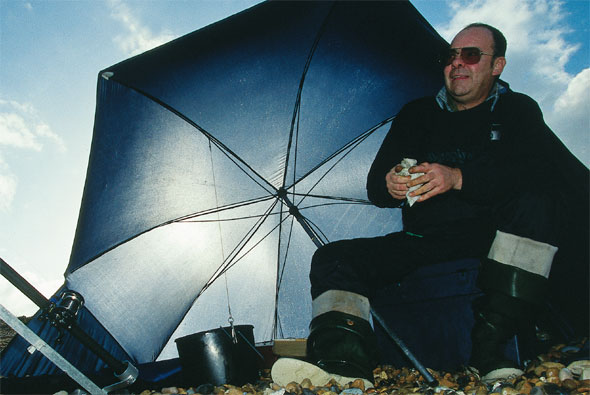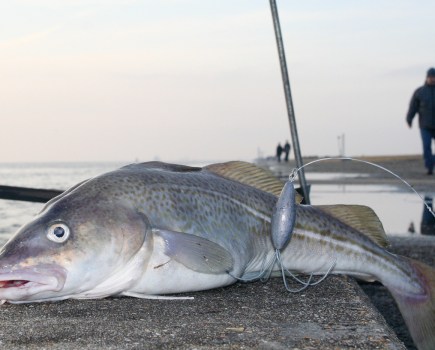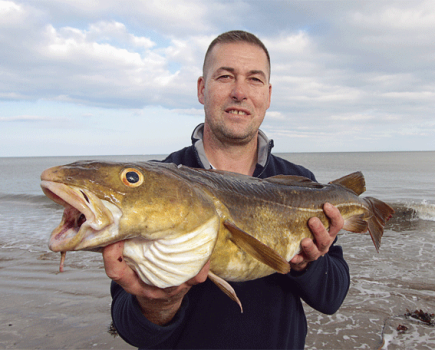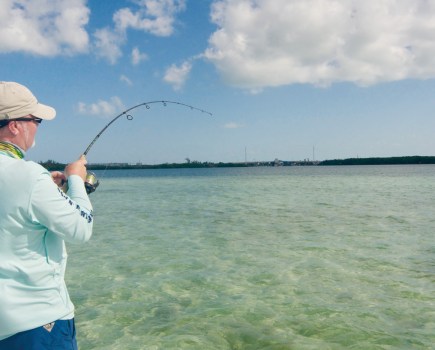The cod season is under way. The bigger fish are closing in on the shoreline and, by the second week of November, the chances of a double-figure fish will be good. Sadly, so should the prospects of genuine winter weather, says Alan Yates, who’s determined to make sure you’re ready for the foul conditions
PLUMMETING temperatures and biting winds begin to be felt by fingers and toes and the rare calm days and nights are invariably frosty, all of which means that shore fishing is no longer easy.
Just casting your bait a reasonable distance and getting it to stay put is difficult in a windswept sea.
Some of the simplest tasks become major problems, like keeping the rod in its rest or lighting a fuel-powered lamp.
Here we look at some things you can do to make life on the beach easier – and more productive…
HOW TO BEAT THE WEATHER…
Clothing
Keeping warm is not a problem because the standard of winter clothing is so high that you can buy an efficient suit for as little as £30. Every angler should have one.
Best buys are the two-piece suits with salopettes and jacket because each can be removed to suit the temperature on the day. One-piece suits, especially those with flotation padding aimed at boat anglers, can be a liability on the shore, so be warned. However, rock and pier/jetty anglers might want to consider wearing one.
 Lighting
Lighting
Ditch the fuel lantern and switch to instant electric. There are a host of super headlamps available with twin beams offering a power light and a working light. Rechargeable base lights are also superb.
Umbrella
Some form of beach shelter is an invaluable aid to keeping warm, providing somewhere to duck out of the elements and keep valuable bait and tackle dry.
There are a range of options, with the umbrella the lightest and best allround shelter, although many are made for coarse fishing and can soon be wrecked or blown away in strong winds, so anchor them securely.
Best choice is a 45in model with wings, which help secure the brolly to the beach and increase the sheltered area. Beware of buying a larger model because it will catch more wind and be harder to anchor. To secure it, bury the lower third in the shingle and fasten the centre pole to your tackle box with a luggage strap.
Beach shelter
Best bet is the original Beach Buddy, which still takes some beating. The look-a-likes are cheaper but will they last the entire season?
Again it’s essential to bury the lower flaps in the beach to keep the shelter in place – this is part of the design – and a bucket piled full of stones is an invaluable aid in high winds.
Wind breaks
The cheapest shelter option and the simplest to erect, wind breaks are widely available from caravan dealers. A canvas strung between several poles is basic but better than nothing.
Not all venues are suitable for a brolly or shelter. Long, shallow beaches, where the angler is required to move with the tide, or steep rock marks rule out ‘base-camp-style’ shelters so it is essential to have the best clothing available.
Lots of anglers fishing from sandy shores opt for chest waders and a waterproof jacket to stay dry and the combination certainly takes some beating, although it is not advisable for dangerous rock marks.
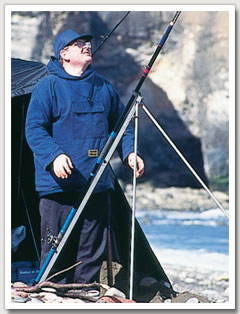 Rod rest stability
Rod rest stability
Modern aluminium tripods are very stable but there are several features you need to look out for when you buy a rod rest to make it even more stable in the worst of the winter weather.
A hook under the tripod can be used to hang a plastic bag full of shingle to help stabilise the rest in high winds. Alternatively you can use a leg brace kit, which is efficient, especially when you can’t dig the legs into shingle or sand.
You can make your own brace by drilling a hole in the bottom of each tripod leg and securing the legs with wire or string to prevent them splaying open. A few rocks piled around the rod rest legs will do instead or you could attach your rest to a railing with a large cable tie.
NOVEMBER REMINDERS
● If you didn’t upgrade your rigs last month then now is the time to increase your hook size and snood strength. In many UK regions, anglers will continue to catch small fish such as whiting, pout, dabs and codling, but a big cod is always possible so change to a minimum 30lb hook snood and if you use a small hook, make sure it’s a tough pattern.
● Winter tests tackle to the extreme so don’t go fishing with just one rod or reel. Take spares. Now is a good time to invest in a second rod or back-up reel. Similarly,
renew your main line and carry a spare.
● For night fishing, a small LED headlamp is a good standby in emergencies. They are not expensive.
● The extreme weather conditions in November invariably create bait shortages and result in higher worm prices. Order bait from your regular dealer.
● Get a thick woolly hat to retain your body heat, most of which is lost through the top of your head. On a beach that’s firmly in the grip of winter, warmth takes precedence over fashion!
● Check out last year’s diary for information and hints about tackle, venues etc. If you didn’t keep a diary, drag out some back copies of Sea Angler and check what was caught where.
● Finally, keep warm, dry and out of the wind. Hot food and drink also boosts morale… and catching power.
TIDE TABLE
If you don’t possess a current tide table then get one pronto. No sea angler should be without one. No other item of equipment is more valuable at this time of year. A tide table helps you choose the best times to fish because the movement of the tide is a major force in fish behaviour.
You will find that certain tides and weather conditions are more favourable for some venues than others and such knowledge can save you many chilly blanks.
At a majority of venues, spring tides are ideal, especially at times when the sun and moon are nearest the earth causing spring tides to peak. The fact that spring and neap tides occur in alternate weeks means that the perfect tidal conditions for many venues around the country only occur for a few days in each fortnight.
Weather is an unpredictable factor although when an onshore wind coincides with a spring tide, fishing can certainly be at its best for some venues. Alternatively, the aftermath of a strong onshore gale can mean fishing is also good during neap tides.
Shore anglers can apply this knowledge with a few generalisations:
● Spring tides: good for fishing from most venues.
● Spring tides when calm: best for night fishing.
● Neap tides when rough: best for deep water in daylight on venues where tide is strong.
● Neap tides when calm: best for deep water in darkness on venues where tide is strong.
Apart from the information on the best tides to fish and the time of high and low water, tide tables also indicate the lowest tides when the sea retreats the furthest. Tides like these are best for bait digging.
Low water spring tides can uncover rarely-dug virgin territory. They become an invaluable aid to getting a supply of hard-to-obtain baits like black lugworm, white ragworm and shellfish like razorfish as well as allowing you to survey the bottom.
Many tackle dealers or angling clubs produce their own tide tables or the local chandlers will have one. They cost around £1.

